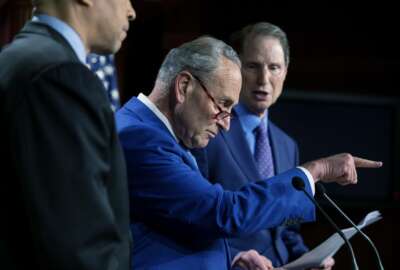Hubbard Radio Washington DC, LLC. All rights reserved. This website is not intended for users located within the European Economic Area.
Remains of TWA Flight 800 will be scrapped after 25 years in storage
Few events have affected the National Transportation Safety Board as much as TWA Flight 800. Now the reassembled fuselage of the doomed 747 is about to be scrap...
Best listening experience is on Chrome, Firefox or Safari. Subscribe to Federal Drive’s daily audio interviews on Apple Podcasts or PodcastOne.
Few events have affected the National Transportation Safety Board as much as TWA Flight 800. It tragically exploded 12 minutes after departing New York back in 1996. It touched off a year’s long investigation and a long list of lessons learned. Now the reassembled fuselage of the doomed 747, in storage in a Virginia warehouse for the last 25-some years, is about to be scrapped. For some perspective on the significance of the moment, Federal Drive with Tom Temin turned to the NTSB’s managing director, Sharon Bryson. And the chief advisor for international affairs, Frank Hilldrup.
Interview transcript:
Tom Temin: Ms. Bryson, good to have you on.
Sharon Bryson: Thank you.
Tom Temin: And to the chief advisor for international affairs, Frank Hilldrup. Mr. Hilldrup, good to have you on.
Frank Hilldrup: Good morning, Tom.
Tom Temin: Let’s begin with the immediate future here. This reassembled fuselage which the images were famous at the time of the plane recovered from the ocean and the whole accident reconstructed. What’s going to happen next with this and why?
Sharon Bryson: The training center lease comes to an end in 2023. And as a part of our assessment of our training needs, and the way forward, there was a decision made that we could train in today’s digital environment without having to have the actual reconstruction to be able to do that. And so it is the 25th anniversary of this tragic accident. And along with the the closing of the training center facility, we felt that it was a good time for us to decommission the reconstruction that was so critical in the investigation in the early days.
Tom Temin: In other words, this reconstruction has been used to teach new generations of investigators what to look for in aircraft wreckage, but now that can be done with simulations, fair way to put it?
Sharon Bryson: That’s correct. It’s been here since 2003. We were fortunate enough to have the victims families, those impacted most by this tragedy, allow us to use it for all those years for training purposes. And it has certainly served a great purpose in that regard. And we’re very much appreciative of them, allowing us to use it for training purposes.
Tom Temin: Got it. So it will be scrapped. And the investigation itself was a long one. It took several years for the NTSB to come up with in fact, the engineer that devised what was the most likely scenario when a Service to America Medals because I interviewed him a number of years ago in analyzing that quarter second of tape that seemed to indicate what happened to the fuel tank which exploded. How did that change the NTSB and some of the intragovernmental arguments that ensued after the accident?
Sharon Bryson: The accident investigation itself took about four and a half years total. It’s not the longest investigation in our agency’s history. But certainly the next two, the longest investigation that we’ve conducted, the reconstructions shows, I think demonstrates clearly the extent to which our agency will go in order to be able to be sure that we have it right prior to making any recommendations for changes. Certainly you you hit on a very good point there. There are really three things I think that are that are key coming out of this accident for the agency. Number one, there was the passage of the aviation disaster Family Assistance Act, which changed the way family members were treated the information they were provided all of that following a major aviation disaster. The second was that it was very clear that there were federal agencies that needed to work more closely together. And that when an accident or tragedy like this happens, it’s important for our government to speak with one voice to those people who were most significantly impacted. And then the last is, I think, for our agency, the idea that when we make a recommendation that at the moment in time, doesn’t have a clear path for implementation. We still need to make those recommendations. Our recommendation and our the fact that it was on our most wanted list for 10 years is what we believe caused the development of that technology that today makes aircraft far more safe.
Tom Temin: We are speaking with Sharon Bryson, managing director of the National Transportation Safety Board. And with Frank Hilldrup, the chief adviser for international affairs. And Frank, you were at the scene I understand at the aftermath of that crash. Tell us what you recall, and then let’s get into some of the reconstruction details.
Frank Hilldrup: Well, I was part of the go-team that that was dispatched early the morning following the accident. You know, there was so much activity when we got up into the area, lots of FBI personnel, lots of other assistance from local authorities. I recall it being quite overwhelming of a scene. We knew he had a huge job ahead of us. And we had to start that process of reconstruction is at some point, but first to do that we had to recover records. So that was the first thing I remember, but this is we’ve done this before. It’s the kind of thing that we have to just have a process and stick with it. And I think that over time, that’s what we had, eventually, we have recovered enough wreckage to start to see certain aspects in the wreckage and also begin the idea of reconstruction.
Tom Temin: And were you aided by the fact that it did take place one over the ocean so that all the parts didn’t burn up, as they often do when planes hit the ground, big planes like that at high speed, and also by the fact that it wasn’t very far off shore that it did occur, such that you could recover most of the pieces within a reasonable amount of time?
Frank Hilldrup: Well, I think that’s a good point. It certainly, obviously, when we have an event and inflight event in flight, fire, and a lot of cases, if there’s a post crash fire, it may obscure that kind of damage. So that is a good point. And that certainly was something maybe in our favor a little bit, but then you’re dealing with the water recovery. Luckily, it was drivable, we had a huge assistance from the Navy divers. And it took quite a bit of time. The other thing that we realized pretty early on, we all knew about what the stories and speculation are rumors, we had seen certain things on on tape ourselves, to wonder what may have been involved here. But we knew we had to have in a very, very extensive recovery effort, which continued throughout the year, to the point where even we use kind of a scallop trawler to just dredge under the sand and make sure we got everything. But we had to answer the questions for ourselves. We had to answer questions for the FBI. And we had to answer questions for the for the public. And that’s ultimately what you see with the with the extent of our recovery center of our reconstruction. that’s those are the reasons that we went to such great lengths, we wanted to be sure we not only ruled a lot out along the process, I don’t think people understand how much that’s part of our investigative process is to rule out certain aspects as we go along, but maintaining focus on on where the evidence is leading us.
Tom Temin: And you needed 93 feet of fuselage to really determine in this case, in contrast with say, you know, the earlier flight where an American Airlines engine fell off where you could concentrate on that part of the plane, and you wouldn’t need the tail to find out why an engine fell off. In this case, you needed as much of the plane as you could possibly reconstruct correct.
Frank Hilldrup: I think that’s mostly correct. Obviously the airplane 93 feet is perhaps maybe around half of the length of the airplane. I’m not sure exactly. But it we certainly could have done more. But we we reconstructed what we needed around the center wing tank, as we began recovering more wreckage and starting to look at that that’s where there was a lot of interesting pieces with fire damage the pieces again, the pieces that were found earliest in the debris path, were several parts from around including part of the center wing tag. And obviously, that’s going to tell you quite a bit. So our focus went there within the weeks of starting to recover things. But we also wanted to extend the reconstruction to make sure that, to answer your question, that it could have been some external event, perhaps, and make sure everybody saw what we saw, make sure we’re answering questions for the FBI, once again, to make sure we had enough wreckage and reconstruction around the center wing tank to answer all of those questions.
Tom Temin: And that was early in the internet age or the mass internet age, there was a lot of speculation on internet forums and email at that time that seemed to take that had a different view of what happened. They thought there was some conspiracy to cover up a missile attack and so forth. And people thought they saw these things. But in the end, you had to kind of filter out, I guess I’m asking you Ms. Bryson, that’s got to be a factor nowadays is to make sure people stick to the facts of the investigation, and try to tune out all that internet noise.
Sharon Bryson: That’s correct. This agency, this independent agency is responsible to gather those facts. And we present those facts once they’re vetted, we will release information, I’m sure you’re aware of some of that we release information that we know to be factual as we’re going through the investigation, and try to stay the course with those things that we know to be factual. And by the way, you mentioned that this investigation was the second longest what was the longest the US Airways 427 accident that happened in Pennsylvania prior to TWA 800. And when I say difference in time, it’s really a few months in terms of length of time for the investigations, but technically 427 was a longer investigation.
Tom Temin: Alright, and just to summarize this, then is this something that in the annals of NTSB is taught to new employees and to incoming employees, as this is the quintessential way that we approach things. And now we try to have a good intragovernmental cooperation. And also we we take the time that it takes to get to the bottom of things.
Sharon Bryson: Those very basic principles are taught to our investigators and taught as much as we can to those who provide support to us when we’re conducting an accident investigations. I think, as important to that is that these investigations are so important. We simply can’t get it wrong. And we want to take the amount of time that is required to gather the facts, do a good analysis and make recommendations to keep it from ever happening again.
Tom Temin: Sharon Bryson is managing director of the National Transportation Safety Board. Thanks so much for joining me.
Sharon Bryson: Thank you.
Tom Temin: Frank Hilldrup is chief advisor for international affairs there. Thank you as well.
Frank Hilldrup: Hey, thanks a lot.
Copyright © 2024 Federal News Network. All rights reserved. This website is not intended for users located within the European Economic Area.
Tom Temin
Tom Temin is host of the Federal Drive and has been providing insight on federal technology and management issues for more than 30 years.
Follow @tteminWFED





